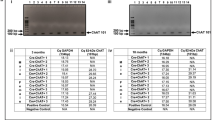Abstract
Neuronal nicotinic receptor binding sites as well as mRNA levels encoding for subunits α4, β2, and α7 were analysed in 3-mo-old transgenic mice generated with a neuronal overexpression of human acetylcholinesterase and in age-matched controls. The acetylcholinesterase transgenic mice display progressive cognitive impairment in spatial learning and memory. We here report a significantly increased [3H]epibatidine and [125I]αbungarotoxin binding in the cortex and the caudate putamen of these mice. Quantitative in situ hybridization showed significant upregulation of mRNA corresponding to the nicotinic receptor subunits α4, β2, and α7 in various brain regions in the transgenic mice compared to nontransgenic controls. Our results suggest that disruption of balanced cholinergic transmission by constitutive overexpression of acetylcholinesterase is accompanied by variable upregulation of several nicotinic receptor subtypes, in particular these associated with cholinergic terminals participating in compensatory response.
Similar content being viewed by others
References
Andres C., Beeri R., Friedman A., Lev-Lehman E., Henis S., Timberg R., Shani M., and Soreq H. (1997) Acetylcholinesterase-transgenic mice display embryonic modulations in spinal cord choline acetyltransferase and neurexin Ibeta gene expression followed by late-onset neuromotor deterioration. Proc. Natl. Acad. Sci. USA 94, 8173–8178.
Beeri R., Andres C., Lev-Lehman E., Timberg R., Huberman T., Shani M., and Soreq H. (1995) Transgenic expression of human acetylcholinesterase induces progressive cognitive deterioration in mice. Curr. Biol. 5, 1063–1071.
Beeri R., Le Novere N., Mervis R., Huberman T., Grauer E., Changeux J. P., and Soreq H. (1997) Enhanced hemicholinium binding and attenuated dendrite branching in cognitively impaired acetylcholinesterase-transgenic mice. J. Neurochem. 69, 2441–2451.
Benwell M. E., Balfour D. J., and Anderson J. M. (1988) Evidence that tobacco smoking increases the density of (-)-[3H]nicotine binding sites in human brain. J. Neurochem. 50, 1243–1247.
Erb C., Troost J., Kopf S., Schmitt U., Loffelholz K., Soreq H., and Klein J. (2001) Compensatory mechanisms enhance hippocampal acetylcholine release in transgenic mice expressing human acetylcholinesterase. J. Neurochem. 77, 638–646.
Gomez J. L., Garcia-Ayllon M. S., Campoy F. J., and Vidal C. J. (2000) Muscular dystrophy alters the processing of light acetylcholinesterase but not butyrylcholinesterase forms in liver of lama2(dy) mice. J. Neurosci. Res. 62, 134–145.
Kaufer D., Friedman A., Seidman S., and Soreq H. (1998) Acute stress facilitates long-lasting changes in cholinergic gene expression. Nature 393, 373–377.
Koelle G. B. (1951) The elimination of enzymatic diffusion artefacts in the histochemical localisation of cholinesterase and a survey of their cellular distribution. J. Pharmacol. Exp. Ther. 103, 153–171.
Li B., Stribley J. A., Ticu A., Xie W., Schopfer L. M., Hammond P., et al. (2000) Abundant tissue butyrylcholinesterase and its possible function in the acetylcholinesterase knockout mouse. J. Neurochem. 75, 1320–1331.
Marks M. J., Pauly J. R., Gross S. D., Deneris E. S., Hermans-Borgmeyer I., Heinemann S. F., and Collins A. C. (1992) Nicotine binding and nicotinic receptor subunit RNA after chronic nicotine treatment. J. Neurosci. 12, 2765–2784.
Nordberg A. (1999) PET studies and cholinergic therapy in Alzheimer’s disease. Rev. Neurol. (Paris) 155, S53-S63.
Nordberg A., Hellström-Lindahl E., Almkvist O., and Meurling L. (1999) Activity of acetylcholinesterase in CSF increases in Alzheimer’s patients after treatment with tacrine. Alzheimer’s Reports 2, 347–352.
Nordberg A., Romanelli L., Sundwall A., Bianchi C., and Beani L. (1989) Effect of acute and subchronic nicotine treatment on cortical acetylcholine release and on nicotinic receptors in rats and guinea-pigs. Br. J. Pharmacol. 98, 71–78.
Peng X., Gerzanich V., Anand R., Whiting P. J., and Lindstrom J. (1994) Nicotine-induced increase in neuronal nicotinic receptors results from a decrease in the rate of receptor turnover. Mol. Pharmacol. 46, 523–530.
Perry E., Martin-Ruiz C., Lee M., Griffiths M., Johnson M., Piggott M., et al. (2000) Nicotinic receptor subtypes in human brain ageing, Alzheimer and Lewy body diseases. Eur. J. Pharmacol. 393, 215–222.
Shapira M., Grant A., Korner M., and Soreq H. (2000a) Genomic and transcriptional characterization of the human ACHE locus: complex involvement with acquired and inherited diseases. Isr. Med. Assoc. J. 2, 470–473.
Shapira M., Tur-Kaspa I., Bosgraaf L., Livni N., Grant A. D., Grisaru D., et al. (2000b) A transcription-activating polymorphism in the ACHE promoter associated with acute sensitivity to anti-acetylcholinesterases. Hum. Mol. Genet. 9, 1273–1281.
Sternfeld M., Shoham S., Klein O., Flores-Flores C., Evron T., Idelson G. H., et al. (2000) Excess “read-through” acetylcholinesterase attenuates but the “synaptic” variant intensifies neurodeterioration correlates. Proc. Natl. Acad. Sci. USA 97, 8647–8652.
Svensson A-L. and Nordberg A. (1996) Tacrine interacts with an allosteric activator site on alpha 4 beta 2 nAChRs in M10 cells. Neuroreport 7, 2201–2205.
von der Kammer H., Mayhaus M., Albrecht C., Enderich J., Wegner M., and Nitsch R. M. (1998) Muscarinic acetylcholine receptors activate expression of the EGR gene family of transcription factors. J. Biol. Chem. 273, 14538–14544.
Wilcox J. N. (1993) Fundamental principles of in situ hybridization. J. Histochem. Cytochem. 41, 1725–1733.
Zhang X., Gong Z. H., and Nordberg A. (1994) Effects of chronic treatment with (+)- and (−)-nicotine on nicotinic acetylcholine receptors and N-methyl-D-aspartate receptors in rat brain. Brain Res. 644, 32–39.
Zhang X., Liu C., Miao H., Gong Z. H., and Nordberg A. (1998) Postnatal changes of nicotinic acetylcholine receptor alpha 2, alpha 3, alpha 4, alpha 7 and beta 2 subunits genes expression in rat brain. Int. J. Dev. Neurosci. 16, 507–518.
Author information
Authors and Affiliations
Corresponding author
Rights and permissions
About this article
Cite this article
Svedberg, M.M., Svensson, AL., Johnson, M. et al. Upregulation of neuronal nicotinic receptor subunits α4, β2, and α7 in transgenic mice overexpressing human acetylcholinesterase. J Mol Neurosci 18, 211–222 (2002). https://doi.org/10.1385/JMN:18:3:211
Received:
Accepted:
Issue Date:
DOI: https://doi.org/10.1385/JMN:18:3:211




